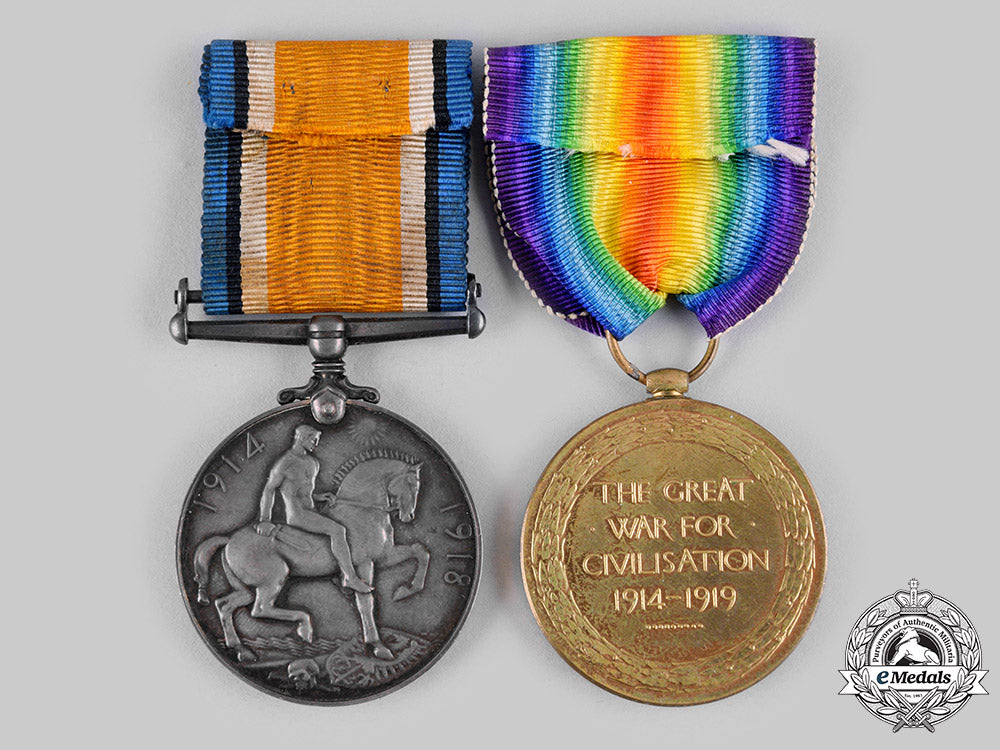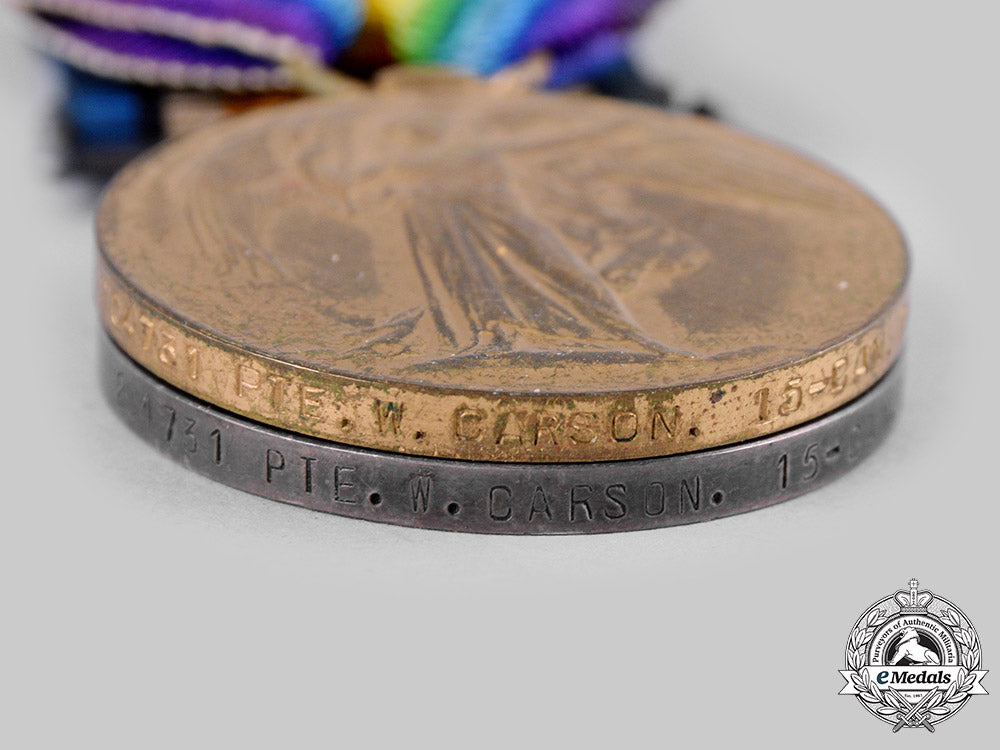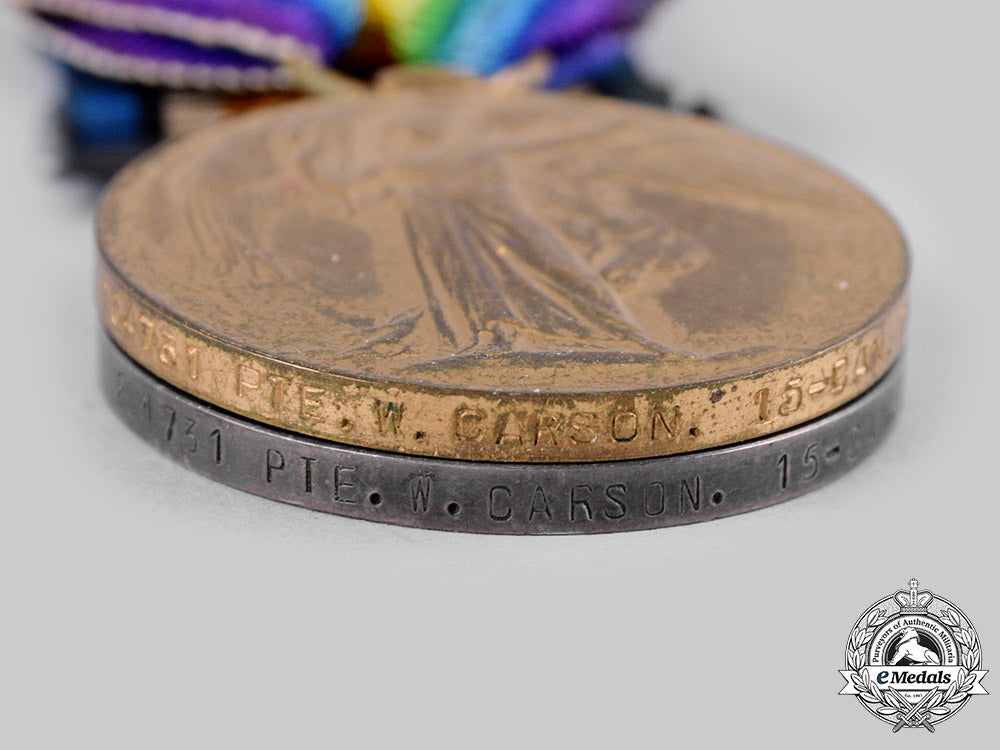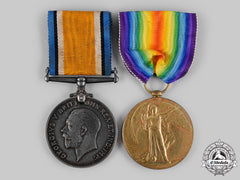
LOADING ...
In response to evolving domestic opinion, eMedals Inc has made the conscious decision to remove the presentation of German Third Reich historical artifacts from our online catalogue. For three decades, eMedals Inc has made an effort to preserve history in all its forms. As historians and researchers, we have managed sensitive articles and materials with the greatest of care and respect for their past and present social context. We acknowledge the growing sentiments put forth by the Canadian public and have taken proactive actions to address this opinion.



Canada, Cef. A First War Pair, To Private Carson, 15Th Battalion, Wounded At Battle Of Vimy Ridge
Canada, Cef. A First War Pair, To Private Carson, 15Th Battalion, Wounded At Battle Of Vimy Ridge
SKU: ITEM: C6097
Current Bid:
Your Max Bid:
Bid History:
Time Remaining:
Couldn't load pickup availability
Shipping Details
Shipping Details
eMedals offers rapid domestic and international shipping. Orders received prior to 12:00pm (EST) will be shipped on the same business day.* Orders placed on Canadian Federal holidays will be dispatched the subsequent business day. Courier tracking numbers are provided for all shipments. All items purchased from eMedals can be returned for a full monetary refund or merchandise credit, providing the criteria presented in our Terms & Conditions are met. *Please note that the addition of a COA may impact dispatch time.
Shipping Details
eMedals offers rapid domestic and international shipping. Orders received prior to 12:00pm (EST) will be shipped on the same business day.* Orders placed on Canadian Federal holidays will be dispatched the subsequent business day. Courier tracking numbers are provided for all shipments. All items purchased from eMedals can be returned for a full monetary refund or merchandise credit, providing the criteria presented in our Terms & Conditions are met. *Please note that the addition of a COA may impact dispatch time.
Description
Description
British War Medal (204731 PTE. W. CARSON. 15-CAN.INF.); and Victory Medal (204731 PTE. W. CARSON. 15-CAN.INF.). Naming is officially impressed. Un-mounted, dark patina on the BWM, contact marks and gilt wear on the VM, the BWM with an original ribbon, the VM with a replacement ribbon, very fine.
Footnote: William Carson was born on November 8, 1889 in Dumfries, Scotland. He was a resident of Saskatoon, Saskatchewan when he signed his Attestation Paper as a Private (204731) with the 96th Infantry Battalion "Canadian Highlanders", on April 13, 1916 in Saskatoon, at the age of 26, naming his next-of-kin as his father, John Carson of Sterling, Scotland (which was later changed to his sister, Annie McCallum of Saskatoon, as his mother was deceased), stating that he had no previous military service, that he was not married, that his religion was Presbyterian and that his trade was that of Mill Hand. The Battalion was raised in Saskatoon and district with mobilization headquarters at Saskatoon, Saskatchewan under the authority of G.O. 151, December 22, 1915. The Battalion sailed September 27, 1916 from Halifax, Nova Scotia, aboard the S.S. Laconia, under the command of Lieutenant-Colonel J. Glenn with a strength of 29 officers and 768 other ranks, arriving in Liverpool, England on October 6th. Upon arriving in England, he was transferred to the 92nd Infantry Battalion on October 9th at East Sandling, as was the remainder of the 96th Infantry Battalion. Three months later, he was transferred to the 5th Reserve Battalion at Bramshott on January 4, 1917. Forty-four days would elapse before Private Carson was transferred to the 15th Infantry Battalion for service in the French theatre, on February 17, 1917, arriving at the Canadian Base Depot in France on February 22nd, leaving for his new unit in the field on the 24th and joining them on the 27th. Private Carson was with the 15th Infantry Battalion, when he was wounded in action during the Battle of Vimy Ridge, on April 9, 1917, suffering a gun shot (shrapnel) wound to his right shoulder and back: the bullet entering the front, piercing his lung and emerging from his back. He was admitted the following day to No. 7 Canadian General Hospital at Etaples on April 10th, where the bullet was removed. Once his condition was stabilized, he was invalided to England and posted to the 1st Central Ontario Regimental Depot at Shorncliffe on April 22, 1917.
Private Carson was admitted to 2nd Western General Hospital in Manchester on April 24, 1917, where multiple pieces of bone were removed from his shoulder and dressings applied. After six months at Manchester, he was transferred and admitted to No. 4 Canadian General Hospital at Basingstoke on October 22nd for additional treatment, before being transferred eleven weeks later to No. 5 Canadian General Hospital in Liverpool on January 5, 1918. He would remain at Liverpool for one month, awaiting return to Canada. Private Carson was invalided to Canada aboard the S.S. Araguaya on February 4, 1918, arriving in Canada on the 15th. He would spend the next three years being treated and recuperating at various facilities in Western Canada. He was posted to Military District No. 12 and placed in a Convalescent Home in Regina, Saskatchewan on February 26, 1918, then transferred to the Military Hospitals Commission Command (MHCC) at the Military Convalescent Hospital in Moose Jaw, Saskatchewan on April 4, 1918. This was followed by a posting to Military District No. 10 and his admission to the Manitoba Military Convalescent Hospital at Tuxedo Park in Winnipeg, Manitoba, on June 30, 1918, as well as seeking treatment at Winnipeg General Hospital as of September 5th.
He remained under the auspices of Military District No. 10 through 1919, 1920 and 1921. The full extent of his injuries and the devastating effects that it had on his body were documented in his Medical History of an Invalid Report, dated April 21, 1921, at the Manitoba Military Hospital, No. 10 Military District in Winnipeg, where he had been since August 12, 1920. It described the "partial loss of function to his right shoulder and arm" as a result of the gun shot wound to his right shoulder, which produced a "great mass of scar about the right clavicle, shoulder over scapula, and on right side of (the) chest. This scar tissue is adherent and will not move freely. The right clavicle was fractured, and the outer half destroyed along with the acromion process and corscoid process of the scapula, thus the right shoulder joint has for articulating surfaces only the head of the humerus and glenoid cavity of the scapula. Movement at the right shoulder is distinctly limited." The report went on to state that the "The upper insertion of biceps has been injured. There is loss of tissue in (the) right arm". The injuries incurred presented challenges and necessitated adjustments on the part of Private Carson: "He can just touch his mouth with (the) tips of (the) fingers of (his) right hand. When shaving, (he) can manage to reach his face by twisting his neck to the right. Has pain in the shoulder if he keeps (the) arm in one position for any length of time. The right shoulder, as a joint, is practically useless to him; and, to perform any work, the object with which he is working must be at a lower level than his waist and on his right side". The Report also went into detail, documenting the timeline, the extent of the injuries and surgeries: "Wounded in (the) right shoulder on April 9, 1917. Clavicle fractured. Blood came from the mouth as soon as he was hit and continued for two days. He has not coughed any more since. Walked out of the line, (was) dressed and sent to Etaples. Wound cleaned up and tube put in. One operation in England and more bone removed. Discharging freely. More dead bone removed on arrival in Canada. July 25, 1918, Operation: a great collection of bone removed from (the) shoulder region. Wound continued to discharge. March 13, 1919, more dead bone removed. Had bismuth injections every four days, but discharge continued. March 12, 1920, sinus opened and cavity found. May 7, 1920, six pieces of dead bone removed. Abscess formed in July 1920. October 22, 1920, scars excised, and wound healed". The Medical Board declared him to be Category "E" - Unfit for General Service, Service Abroad and Home Service (Categories "A,B,C") on April 21, 1921, the Assistant Director of Medical Services approving the recommendation on April 23rd. Private William Carson, 96th Infantry Battalion, 15th Infantry Battalion was "discharged from service by reason of medical unfitness", at No. 10 Military District in Winnipeg, Manitoba, on April 30, 1921, credited with having served in Canada, England and France, entitled to wear the War Service Badge, Class "A", the number not disclosed in his records. For his First World War service, he was awarded the British War Medal and the Victory Medal. He died on April 14, 1952, at the age of 62 and is buried in Brookside Cemetery, in Winnipeg, Greater Winnipeg, Manitoba, Plot: Military-2863-0.
Description
British War Medal (204731 PTE. W. CARSON. 15-CAN.INF.); and Victory Medal (204731 PTE. W. CARSON. 15-CAN.INF.). Naming is officially impressed. Un-mounted, dark patina on the BWM, contact marks and gilt wear on the VM, the BWM with an original ribbon, the VM with a replacement ribbon, very fine.
Footnote: William Carson was born on November 8, 1889 in Dumfries, Scotland. He was a resident of Saskatoon, Saskatchewan when he signed his Attestation Paper as a Private (204731) with the 96th Infantry Battalion "Canadian Highlanders", on April 13, 1916 in Saskatoon, at the age of 26, naming his next-of-kin as his father, John Carson of Sterling, Scotland (which was later changed to his sister, Annie McCallum of Saskatoon, as his mother was deceased), stating that he had no previous military service, that he was not married, that his religion was Presbyterian and that his trade was that of Mill Hand. The Battalion was raised in Saskatoon and district with mobilization headquarters at Saskatoon, Saskatchewan under the authority of G.O. 151, December 22, 1915. The Battalion sailed September 27, 1916 from Halifax, Nova Scotia, aboard the S.S. Laconia, under the command of Lieutenant-Colonel J. Glenn with a strength of 29 officers and 768 other ranks, arriving in Liverpool, England on October 6th. Upon arriving in England, he was transferred to the 92nd Infantry Battalion on October 9th at East Sandling, as was the remainder of the 96th Infantry Battalion. Three months later, he was transferred to the 5th Reserve Battalion at Bramshott on January 4, 1917. Forty-four days would elapse before Private Carson was transferred to the 15th Infantry Battalion for service in the French theatre, on February 17, 1917, arriving at the Canadian Base Depot in France on February 22nd, leaving for his new unit in the field on the 24th and joining them on the 27th. Private Carson was with the 15th Infantry Battalion, when he was wounded in action during the Battle of Vimy Ridge, on April 9, 1917, suffering a gun shot (shrapnel) wound to his right shoulder and back: the bullet entering the front, piercing his lung and emerging from his back. He was admitted the following day to No. 7 Canadian General Hospital at Etaples on April 10th, where the bullet was removed. Once his condition was stabilized, he was invalided to England and posted to the 1st Central Ontario Regimental Depot at Shorncliffe on April 22, 1917.
Private Carson was admitted to 2nd Western General Hospital in Manchester on April 24, 1917, where multiple pieces of bone were removed from his shoulder and dressings applied. After six months at Manchester, he was transferred and admitted to No. 4 Canadian General Hospital at Basingstoke on October 22nd for additional treatment, before being transferred eleven weeks later to No. 5 Canadian General Hospital in Liverpool on January 5, 1918. He would remain at Liverpool for one month, awaiting return to Canada. Private Carson was invalided to Canada aboard the S.S. Araguaya on February 4, 1918, arriving in Canada on the 15th. He would spend the next three years being treated and recuperating at various facilities in Western Canada. He was posted to Military District No. 12 and placed in a Convalescent Home in Regina, Saskatchewan on February 26, 1918, then transferred to the Military Hospitals Commission Command (MHCC) at the Military Convalescent Hospital in Moose Jaw, Saskatchewan on April 4, 1918. This was followed by a posting to Military District No. 10 and his admission to the Manitoba Military Convalescent Hospital at Tuxedo Park in Winnipeg, Manitoba, on June 30, 1918, as well as seeking treatment at Winnipeg General Hospital as of September 5th.
He remained under the auspices of Military District No. 10 through 1919, 1920 and 1921. The full extent of his injuries and the devastating effects that it had on his body were documented in his Medical History of an Invalid Report, dated April 21, 1921, at the Manitoba Military Hospital, No. 10 Military District in Winnipeg, where he had been since August 12, 1920. It described the "partial loss of function to his right shoulder and arm" as a result of the gun shot wound to his right shoulder, which produced a "great mass of scar about the right clavicle, shoulder over scapula, and on right side of (the) chest. This scar tissue is adherent and will not move freely. The right clavicle was fractured, and the outer half destroyed along with the acromion process and corscoid process of the scapula, thus the right shoulder joint has for articulating surfaces only the head of the humerus and glenoid cavity of the scapula. Movement at the right shoulder is distinctly limited." The report went on to state that the "The upper insertion of biceps has been injured. There is loss of tissue in (the) right arm". The injuries incurred presented challenges and necessitated adjustments on the part of Private Carson: "He can just touch his mouth with (the) tips of (the) fingers of (his) right hand. When shaving, (he) can manage to reach his face by twisting his neck to the right. Has pain in the shoulder if he keeps (the) arm in one position for any length of time. The right shoulder, as a joint, is practically useless to him; and, to perform any work, the object with which he is working must be at a lower level than his waist and on his right side". The Report also went into detail, documenting the timeline, the extent of the injuries and surgeries: "Wounded in (the) right shoulder on April 9, 1917. Clavicle fractured. Blood came from the mouth as soon as he was hit and continued for two days. He has not coughed any more since. Walked out of the line, (was) dressed and sent to Etaples. Wound cleaned up and tube put in. One operation in England and more bone removed. Discharging freely. More dead bone removed on arrival in Canada. July 25, 1918, Operation: a great collection of bone removed from (the) shoulder region. Wound continued to discharge. March 13, 1919, more dead bone removed. Had bismuth injections every four days, but discharge continued. March 12, 1920, sinus opened and cavity found. May 7, 1920, six pieces of dead bone removed. Abscess formed in July 1920. October 22, 1920, scars excised, and wound healed". The Medical Board declared him to be Category "E" - Unfit for General Service, Service Abroad and Home Service (Categories "A,B,C") on April 21, 1921, the Assistant Director of Medical Services approving the recommendation on April 23rd. Private William Carson, 96th Infantry Battalion, 15th Infantry Battalion was "discharged from service by reason of medical unfitness", at No. 10 Military District in Winnipeg, Manitoba, on April 30, 1921, credited with having served in Canada, England and France, entitled to wear the War Service Badge, Class "A", the number not disclosed in his records. For his First World War service, he was awarded the British War Medal and the Victory Medal. He died on April 14, 1952, at the age of 62 and is buried in Brookside Cemetery, in Winnipeg, Greater Winnipeg, Manitoba, Plot: Military-2863-0.



You May Also Like
Germany, SA. A Model 1933 Service Dagger, SA-Gruppe Nordsee, by Friedrich von der Kohlen
G59818
Germany, SA. A Model 1933 Service Dagger, SA-Gruppe Pommern, by Gustav Wirth
G59816
Germany, Third Reich. A Mixed Lot of Tyrolean Marksmanship Badges
G52930
Germany, SS. An Estonian Waffen-SS Volunteer’s Sleeve Shield
G50381
Germany, SS. A Waffen-SS Sturmmann Sleeve Insignia
G52846
-
Germany, SA. A Model 1933 Service Dagger, SA-Gruppe Nordsee, by Friedrich von der Kohlen
G59818
Add to CartRegular price $980 USDRegular price $0 USD Sale price $980 USDUnit price / per -
Germany, SA. A Model 1933 Service Dagger, SA-Gruppe Pommern, by Gustav Wirth
G59816
Add to CartRegular price $980 USDRegular price $0 USD Sale price $980 USDUnit price / per -
Germany, Third Reich. A Mixed Lot of Tyrolean Marksmanship Badges
G52930
Add to CartRegular price $135 USDRegular price $0 USD Sale price $135 USDUnit price / per -
Germany, SS. An Estonian Waffen-SS Volunteer’s Sleeve Shield
G50381
Add to CartRegular price $150 USDRegular price $0 USD Sale price $150 USDUnit price / per -
Germany, SS. A Waffen-SS Sturmmann Sleeve Insignia
G52846
Add to CartRegular price $135 USDRegular price $0 USD Sale price $135 USDUnit price / per
Do you have a similar item you are interested in selling?
Please complete the form and our client care representatives will contact you.
Sell Item










